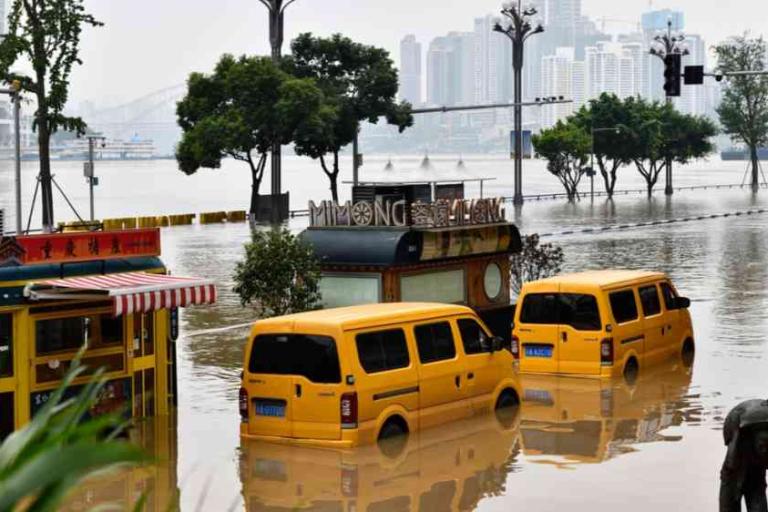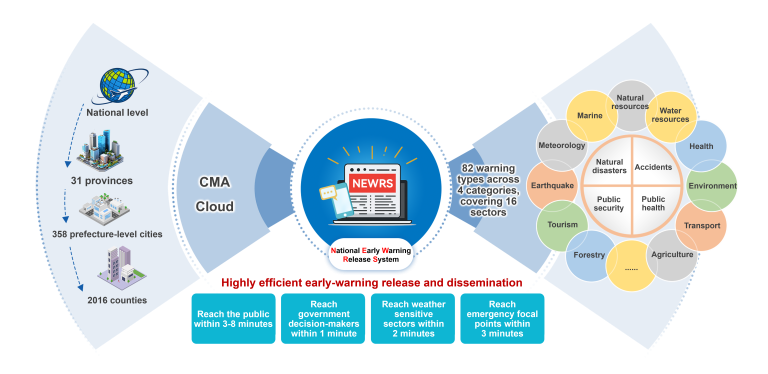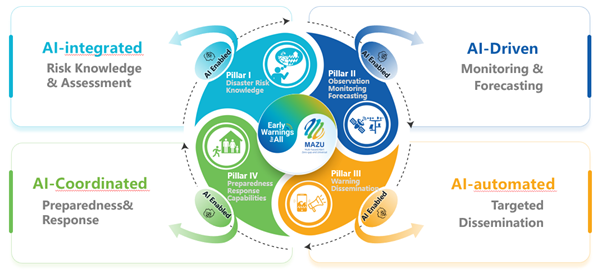Governance and Artificial Intelligence, the Keys to an Integrated End-to-End Approach to Early Warnings for All
- Author(s):
- By Dr CHEN Zhenlin, Administrator of the China Meteorological Administration (CMA) and Permanent Representative of China with the World Meteorological Organization (WMO)

The challenge to public security due to increasingly more frequent any and intense extreme weather events, which are driven by climate change, is the backdrop of the United Nations Secretary-General António Guterres launch of the Early Warnings for All (EW4All). In this grand ambition lies a paradox: though research and technological advancements have made forecasts and warnings more timely and sophisticated, natural hazards have continued to cumulate tragic casualties. This reveals that the traditional warning paradigm, based solely on technological advancement and information dissemination, is coming to a head just when humanity is experiencing more extreme events than ever before. A comprehensive governance system that can effectively translate scientific signals and warnings into social action is urgently needed.
Through institutional architecture, technological innovation and social mobilization, China has transformed scientific capacity into social capability to protect lives. On the occasion the 10th anniversary of China's National Emergency Early Warning Information Release Centre in 2025, the China Meteorological Administration (CMA) would like to share its exploration and practice in this area.
Institutional architecture: Embedding accountability into standard operating procedures
From its initial design, China’s early warning process was conceived as a governance framework rather than a mere technical system. Under China’s people-centred philosophy, early warnings have been established as a public responsibility led by the Government in concert with authorities and shared by society. To ensure seamless cross-ministerial coordination, the concertation mechanism was included in the relevant Chinese legal and regulatory frameworks. CMA took the lead, in 2010, in establishing a high-level coordination mechanism that encompassed 28 ministries to ensure that all authorities would work together to protect lives when disasters and crises occur.
In particular, the component of “Call-and-Response (C&R) Protocol for High-Level Alerts"1 makes meteorological warning compulsory and mandatory for those responsible for emergency response by establishing a standard and accountable process, a key implementation measure. By directly binding "high-level alerts" to the Government’s emergency respondents, the governance malpractice that led to "well prepared alerts being simply posted on a platform and well defined responsibilities being stored away in a document" was ended. From the perspective of governance resilience, "C&R" is an essential arrangement that assures that those working at grassroot levels have the authority, competency and resources necessary for independent judgment, prompt decisions and organized relocation in the intense, stressful, time-sensitive situations that occur when disasters loom.
China operates a unified national emergency warning information release system that is vertically connected at the national, provincial, municipal and county levels, horizontally connected with 22 ministries, and uses the Common Alert Protocol (CAP). The single platform that integrates, processes and disseminates warnings of 220 types in four categories, effectively resolving inconsistent standards and information bottlenecks. The Asian version of WMO Global Multi-hazard Alert System (GMAS-A), which was jointly developed with the Hong Kong Observatory (HKO), enables real-time sharing of warnings with 21 WMO Members in Asia as a contribution to regional standardization.

| Table 1. Selected Performance Indicators and Calculation Methods for China's National Early Warning Information Release System (CMA, 2024) | ||
|---|---|---|
| Indicator | Reported Value | Definition and Calculation Method |
| Population Covered by Early Warnings | 99.12% | Proportion of the national population accessible through at least one primary warning dissemination channel (mobile networks, broadcast media, loud-speakers, etc.) |
| Lead Time for Severe Convective Weather Warnings | 43 minutes | The average time difference between the public issuance of a severe convective weather warning and the first observation of the corresponding phenomenon in that region (based on statistics for all events in 2023) |
| Delivery Time of High-Level Alerts to Decision-Makers | <1 minute | The average time taken for the highest-level (red) alert to be delivered from the platform to the communication terminals of designated emergency managers at all levels |
| Total Annual Number of Warnings Issued | 454,000 | The total number of warnings of all types issued to the public and sector users through the system |
| Annual Reach of Early Warnings (instances) | 28 billion | Total number of warning messages delivered annually across all channels (SMS, app notifications, etc.) |
| "C&R" to and by Emer-gency Managers (instances) | 580,000 | Total number of emergency officials who confirmed receipt of high-level alerts via phone, SMS or other direct communication methods |
The first and last mile
An effective early warning system must address two core challenges:
- ensure that the "First Mile" is authoritative and accurate
- ensure that warnings trigger protective actions – the "Last Mile".
The First Mile – Ensuring authority and accuracy at the First Mile requires continuous enhancement of the monitoring and forecasting of extreme events by looking at each step in the process. First, the integrated land-sea-air-space observation network, through a concept of "Observation-as-a-Service"2, is fine-tuned to better capture quickly evolving extreme weather events. Second, the development of AI-based forecasting models, such as ensemble forecasts with physical constraints, is prioritized to overcome the "smoothing effect" of conventional data-driven AI models. Third, the translation of scientific forecasts into clear, actionable warnings for decision-makers and the public through a dynamic and evolving process for progressive services3.
The Last Mile – The ultimate value of warnings rests on bridging the wide gap between precise scientific signals and effective social action, which is often delayed by the human bias for optimism in face of pending disaster. The Chinese approach focuses on one core objective: to overcome uncertainty by focusing on institutional and technological certainties.
Strategy 1: Ensure that warnings "arrive in time" and are "correctly understood" - The unified platform and multichannel communication (radio, television, mobile applications, social media, etc.), empowered with 5G positioning, ensures a precise outreach to individuals at risk, while grid-based governance at the grassroots level translates warnings into instructions for action. Using a privacy-by-design principle, only anonymous, aggregated mobile tower data are analysed to assess crowd density in risk areas, with no personal identifiers ever used. Where necessary, traditional methods – such as community workers knocking on doors one-by-one or beating gongs and blowing whistles – are employed to ensure that warnings reach everyone, especially vulnerable groups such as the elderly, children or those with handicaps. Regular community drills help bridge the knowledge-action gap.
Strategy 2: The sector-integrated warning mechanism ensures that warnings are translated into action - With regulations and the "C&R" protocol in place, "a signal seen" is transformed into "a response made". Furthermore, with the integrated "warning + sector" service model implemented, warnings are embedded directly into the sector service process. For example, CMA issues risk warnings of geological hazards and flash floods jointly with ministries of natural and water resources; delivers road weather alerts to over two million truck drivers together with the ministry of transportation; and provides customized weather warnings for more than 660,000 registered tour guides with the ministry of culture and tourism.
The case study below points to the importance of a governance system that deeply integrates institution, technology and social mobilization to overcome delays to action. AI, when embedded across the entire process as a technical engine, adds to the deep integration and overall system performance.
| Case Study: Full-Chain Response to Super Typhoon Yagi (2024) |
|---|
In September 2024, Super Typhoon Yagi, with a central wind force exceeding 17 on the Beaufort scale, made landfall in Hainan Province, providing a stress test of China’s warning system across the entire early warning value chain from the First Mile to the Last Mile. The First Mile: The high-risk areas were accurately delineated 3 days in advance, with the highest-level red typhoon warning issued, explicitly stating that it was most likely to become the strongest typhoon to impact South China in a decade, thus securing a crucial window for emergency response and social mobilization. The Last Mile: The "C&R" protocol was activated so that local governments adopted mandatory measures such as "five suspensions" – of classes, work, business, transportation and markets – in accordance with the law. Before the typhoon could made landfall, Guangdong and Hainan provinces had evacuated over a million residents from high-risk areas, all fishermen had returned to shore and all vessels were secured in harbors. The effectiveness: These measures helped prevent fatalities in the high-impact zones for storm surge and strong wind. Hainan reported 4 deaths and 95 injuries; the full-chain early warning defense model had clearly minimized human casualties. The post-event assessment showed that the early warning services had also reduced economic losses by US$ 1.26 billion4. |

Multi-hazard, Alert, Zero-gap and Universal (MAZU5 )
China released the MAZU International Cooperation Initiative (MICI) at the 2025 World Artificial Intelligence Conference (WAIC) as a technology-driven methodology to be shared with global counterparts. MAZU, which stands for Multi-hazard, Alert, Zero-gap and Universal, will support the four pillars identified in the Early Warnings for All Action Plan,
- Technical solution: AI empowering the four pillars of Early Warnings for All
Pillar 1: AI-integrated risk knowledge – From 2020 to 2022, China conducted its first national comprehensive disaster risk survey, assessing 23 disaster types in six categories as a nationwide risk data base. By fusing meteorological, geographic and socioeconomic data, AI transforms static survey data into dynamic, region-specific risk maps, shifting risk assessment from a passive response to proactive management to inform all warning actions scientifically and logically.
Pillar 2: AI-Driven monitoring & forecasting - Under the title of Feng (wind), CMA has developed AI models for nowcasting, short- to medium-range forecasting and seasonal prediction, reducing the dependence on massive computing resources while improving the timeliness and accuracy of extreme weather forecasts, thus supporting the First Mile.
Pillar 3: AI-automated targeted dissemination - AI upgrades traditional mass alerts to personalized "dialogues" tailored to user profiles, warning levels and hazard types, enabling a precise, targeted delivery to specific regions and groups to ensure warnings are understood and acted upon.
Pillar 4: AI-Coordinated preparedness and response – When high-level warnings activate the C&R protocol, AI evolves from an information assistant to a decision-support adviser. By analysing response status, resource distribution and evolving hazards in real time, it generates optimal proposals and schemes, fostering efficient cross-sectoral coordination. Important Safeguard on responsible AI governance: Effective governance is essential to ensuring responsible AI applications and public trust. To this end, CMA and the Cyberspace Administration of China (CAC) have jointly issued the Measures for AI Applications in Meteorology to regulate access and use of AI in meteorology from the perspectives of law, intellectual property rights and personal data protection, while encouraging innovation.
- Cooperation proposals
Technology Sharing – A drive for extensive consultation, joint construction and shared benefits has driven development of MAZU-branded early warning cloud platforms by China and its partners. For example, a joint platform has been established in collaboration with the Pakistan Meteorological Department (PMD) that includes Pakistan’s self-developed tool for Glacial Lake Outburst Flood (GLOF) warnings. The platform integrates GLOFs in its multi-hazard monitoring, AI-based forecasting, and role-specific emergency guidance.
Capacity Development – Over the next three years, China plans to offer 2 000 short-term training opportunities, 100 scholarships for degree programs and 50 visiting scholar positions and to collaborate with partners to develop their local capacity in early warning and disaster management.
Regional Cooperation – Together with regional partners, CMA operates and supports an online joint defense mechanism for pre-disaster consultations, in-process information sharing and post-disaster reviews for regional high-impact hazardous weather events. In parallel, China will continue to advance data standardization and sharing through the WMO Information System (WIS).
Experience Sharing – CMA will systematically share its practices in institutional and standardsetting aspects – such as disaster risk surveys and assessments, and the “C&R” protocol – to help interested countries to build a solid scientific foundation for risk-informed decisions.

Challenges remain
The Chinese experience demonstrates that an integrated governance system – combining institutional, technological and social mobilization – is effective and efficient as shown in the Super Typhoon Yagi case study. It also brings significant economic benefits: according to an independent third-party assessment, China’s meteorological early warning services contributed to avoiding approximately US$ 83.6 billion6 in economic losses in 2024.
Yet, challenges remain. Every extreme weather event re-emphasizes that precise data points are not the ultimate goal; it is the protection of every human life. It is a shared human imperative that is not limited by borders. CMA stands ready to work with partners worldwide, not only to share technology and experience, but also to shoulder this responsibility: safeguarding our one and only home together.
Footnotes
1. C&R Protocol for High-Level Alerts: Meteorological disaster risk warnings are classified into four levels ranging from low to high: blue (general), yellow (severe), orange (very severe), and red (particularly severe). Orange and red are high-level warnings. "Call" means urgently notifying emergency respondents via phone, and "response" means the respondents taking immediate countermeasures. This two-way accountability loop ensures that warnings are translated into verifiable actions.
2. Observation-as-a-Service refers to the deployment of algorithms directly at observation sites to extract weather hazard features from raw data in near real-time, significantly reducing processing delays and gaining crucial time for warning of sudden on-set extreme events.
3. Progressive Service: Warning services conducted by increasingly refining information in time and space to provide more accuracy on the intensity and impacts – more targeted content – as severe weather evolves.
4. Economic loss reduction assessed by an independent third-party evaluator using an internationally recognized disaster impact assessment methodology, similar to the World Bank's "Triple Dividend of Resilience" framework.
5. MAZU is named after a legendary Chinese fisherwoman (Lin Moniang, 960–987 AD) who saved mariners using her knowledge of weather and astronomy. She is honored as “Mazu”, literally “Maternal Ancestor”, a symbol of wisdom and protection. Her birthday coincides with World Meteorological Day (23 March).
6. According to the National Public Meteorological Service Evaluation 2024 jointly released by China National Bureau of Statistics (NBS) and CMA


